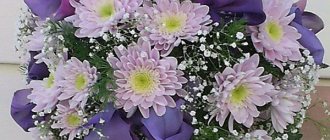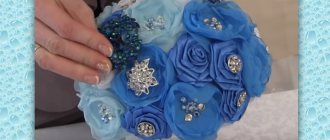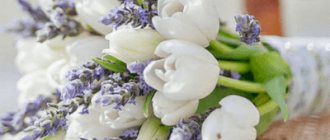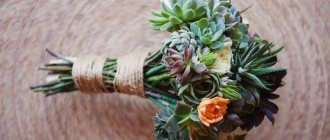Sun symbol
Content
This plant of the Astrov family was first discovered in the East. In the ethnic groups of China and Japan, there are strikingly similar legends about the origin of chrysanthemums, in which they were associated with the sun. In Eastern culture, the chrysanthemum is a sacred plant; it symbolizes power, wisdom and harmony. It was used to decorate imperial clothes, and this flower is still depicted on the coat of arms of Japan. Having reached European countries, this plant quickly gained popularity. Giving a bouquet of chrysanthemums meant showing your respect and wishing you health and wealth. They were presented to noble and wealthy ladies, whom they wanted to make a good impression on. Those who believed in the magical power of plants endowed the chrysanthemum with the ability to attract good luck and money, and promote professional growth.
With the advent of the tradition of giving the bride a wedding bouquet, chrysanthemum became even more popular. Firstly, its flowering period coincides with the wedding season (August-September). Secondly, it looks beautiful both on its own and in composition with other plants. To complement the image of a young girl with delicate, fragile flowers - what could be better? Therefore, a bridal bouquet of fresh chrysanthemums is still popular, despite the abundance of exotic and unusual flowers.
Caring for chrysanthemum Bridal dress
Rules for caring for a chrysanthemum The bride's dress cannot be called complicated. At the same time, it is important that the gardener takes into account the preferences of the plant, creating the most favorable conditions for development and growth.
Optimal growing conditions
Immediately after planting chrysanthemum seeds for seedlings, they should be kept indoors at a constant temperature of + 23-25 ° C, providing them with sufficient light and protection from drafts.
After emergence, after 10-12 days, the containers are transferred to the sunniest windowsill. In the morning and evening they are additionally illuminated with a phytolamp, extending the daylight hours to 12-14 hours. The temperature is reduced to + 16-18 °C. The shelter is gradually removed, increasing the ventilation time every day, and then they get rid of it completely.
After picking the chrysanthemum seedlings, the Bridal Dress continues to provide additional light and maintain the specified temperature. In this case, 2 weeks before transplanting into the flower garden, the plants need to be hardened:
- first, a window is opened in the room with them;
- then every day they are taken out into a greenhouse or onto a glassed-in loggia, leaving them at a temperature of at least + 15 °C, first for an hour or two, then for a longer period of time;
- in the second week, the plants are also gradually accustomed to being outside, exposing them first to the shade and then to the sun.
Place for planting seeds or seedlings of chrysanthemums. The bride's dress in open ground should be sunny, but with shading in the middle of the day. It is necessary that it be protected from drafts, but well ventilated, and also prevent stagnation of moisture at the roots.

You can sow the Bridal Dress chrysanthemum directly into open ground after the soil in the garden has warmed up well
Watering mode
The key to health and successful growth of the chrysanthemum The bride's dress is a properly organized watering regime.
Advice! It is recommended to water the plant with clean water at room temperature, allowing it to settle for a couple of days.
After planting the seeds and before germination, moisten the soil very carefully by spraying it with a spray bottle. This should be done as the top layer of soil dries.
After the Bride's Dress chrysanthemum has sprung up, you can use a syringe or small syringe to water it. Seedlings after picking or seedlings that have grown in the garden bed are watered more generously, while avoiding excessive drying out or waterlogging of the soil.
Caring for an adult Chrysanthemum Bride growing in open ground involves regular watering at the root, avoiding water getting on the leaves and flowers. In the first half of summer, at the stage of bud formation, the plant requires a significant amount of moisture. After the flowers appear, the intensity of watering should be reduced slightly.
Important! The soil at the roots of the chrysanthemum The bride's dress must be loosened every time after moistening, this will provide better aeration and facilitate access to oxygen. The procedure should be performed at least once every 2 weeks, combining it with weeding.
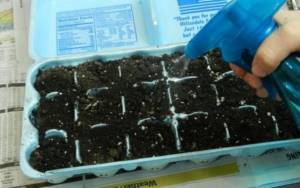
At the initial stage of seed germination, watering should be done from a spray bottle
Fertilizing
Chrysanthemum Bridal Dress, which is grown in seedlings, is usually fed as follows:
- Immediately after picking, it is recommended to spray the seedlings with a biostimulant solution (Epin-Extra or Zircon) for better growth and rooting.
- A week after this, the plant can be fertilized with potassium humate, Fertika Lux or Uniflor for flowers. In the future, fertilizing should be repeated every 2 weeks.
Having transplanted a chrysanthemum into a flower garden, it is recommended to water it with Kornevin solution.
If the seeds were sown directly into the ground, then a week after germination, you need to water them with water with the addition of a small amount of liquid fertilizer (Rainbow, Ideal).
An adult chrysanthemum is fed three times during the summer:
- 1.5 months after planting, nitrogen-containing compounds must be added to the soil to promote the growth and expansion of foliage;
- for the second and third time, the plant is fertilized at the stage of bud formation with preparations that include potassium and phosphorus.
Trimming and shaping
In order for the Bridal Dress chrysanthemum bushes to be compact, but at the same time thick, with a large number of shoots, they should be formed correctly.
During the period of active growth, but before the buds appear (or 7-10 days after planting the seedlings in the ground), you should pinch the upper part of the central shoot. The best option is to wait until the 8th leaf appears and remove the “top” above it.
After the length of the side shoots reaches 20 cm, they can also be pinched. As a result, the Bridal Dress chrysanthemum bushes will resemble dense balls and form many inflorescences.
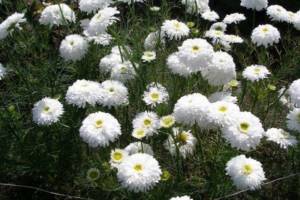
Pinching shoots allows you to form dense, lushly flowering bushes
Features and Benefits
Chrysanthemum is ubiquitous and an unpretentious flower that is easy to grow in your own garden. This also has a positive effect on its cost; a bouquet of chrysanthemums will cost less than the option with capricious and exotic orchids and lilies. This flower looks beautiful in any composition; it has become a favorite of florists and decorators. Chrysanthemums are easy to work with; they have strong and dense stems that still remain flexible. In addition, there are the following advantages: Variety. You can put together a bouquet of different chrysanthemums, and no one will guess that they are flowers of the same species. They can look like daisies, peonies, gerberas, and there are a huge number of color variations. For example, a snow-white chrysanthemum looks very gentle and airy, while a burgundy one looks pretentious and solemn.
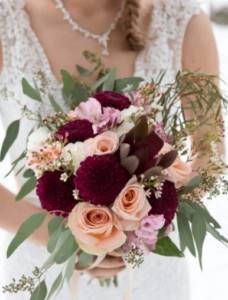
- Persistence. Cut flowers do not fall off for a very long time and tolerate both heat and cold well. If you have a long photo shoot on the street, you can rest assured that the bouquet will survive any walk and remain unchanged.
- Long flowering period. One bush can bloom for a month; different varieties have buds at different times, from July to October. During the rest of the year, chrysanthemums grow in a greenhouse, which does not affect their quality.
- Versatility. Chrysanthemum is perfect for creating a round bouquet and for a cascading composition. Its flowers can be of various sizes - from small flowers to large spherical inflorescences up to 15 centimeters in diameter.
A special feature of chrysanthemums is their aroma. The smell of flowers is memorable, with a slight bitterness. Many people really like it, but there are also those who may find it intrusive. For a small bouquet this is not critical, but for those who want to order a voluminous one, it is better to approach the decision carefully. Complex essential oils are responsible for the aroma of flowers, which can trigger an allergy attack in allergy sufferers.
Features of growing chrysanthemum Bridal dress
The bride's dress is a cultivated variety of odorless chrysanthemum. It can be grown both in open ground and in pots. This is an annual plant - seed ripening, seedling growth and development, flowering and wilting occur during one growing season.
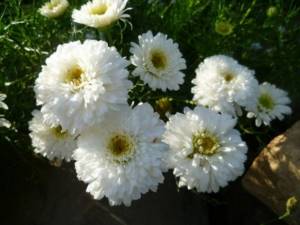
The annual double chrysanthemum Bridal Dress is famous for its lush white flowers with yellow centers
Chrysanthemum Bridal Dress grows quickly, branches well and blooms profusely. Its shoots form dense compact bushes, usually reaching 20 cm in height. The root system is branched and grows parallel to the soil surface. The leaves are emerald green. They are oblong, feathery and arranged in a regular order.
Terry inflorescences-baskets have the shape of a ball 5-6 cm in diameter. Along the edge of each of them there are elongated flowers resembling reeds. They are painted snowy white, while the thin tubular flowers in the middle are bright yellow.
Chrysanthemum blooms Bridal dress from mid-July to October. Its fruits are capsules, inside which seeds ripen.
Comment! Cut branches of chrysanthemum Bridal dress look great in bouquets. In a vase with water, they are able to maintain a fresh and attractive appearance for a long time.
Possible options
Almost any bouquet can be made from chrysanthemums; they are universal due to their diversity. Their beauty is clearly revealed in classic dome-shaped bouquets. To create such a composition, you can use small flowers of the Dune or Altyn Ai varieties; the bouquet will be very elegant and simple at the same time. The florist can also offer options such as:
- Round bouquet. Using a special base, a ball is assembled from flowers; the plants are selected in such a way that the composition is uniform, without protruding branches and leaves. Mostly flowers of the same shade and shape are used, but exceptions are possible.
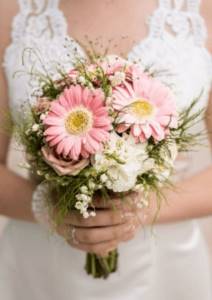
- Cascading bouquet. A relatively new trend in wedding floristry, such compositions, although quite bulky, look very luxurious. At the base are several large inflorescences, from which long stems of exotic greenery, branches of orchids or other climbing flowers cascade down. You can combine different plants, the main requirement is that the stems must be sufficiently flexible and strong. Bush chrysanthemums are perfect for this.
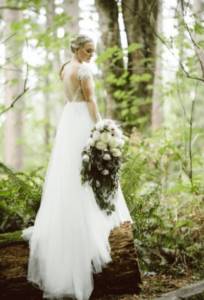
- “Dishesive” bouquet. In such a composition, flowers are gathered as if hastily, individual branches or leaves are knocked out of the general row. To enhance the effect, deliberately rough materials are used as decoration: ropes, burlap.
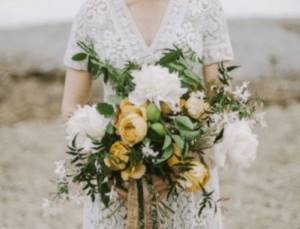
An experienced specialist will suggest an option that suits both the bride’s image and the theme of the wedding. When choosing a bouquet, the florist will take into account a variety of factors: the girl’s appearance, the design of the dress, the bride’s preferences.
Diseases and pests
The diseases and pests that the Bridal Dress chrysanthemum often suffers from can be briefly described as follows:
| Disease/pest | Manifestations | Treatment and prevention measures |
| Gray rot | Light brown spots on leaves and petals. Inflorescences rotting from the base. Softening the stems. | Removal and destruction of affected parts. Thinning bushes. Treatment with Speed, Fundazol, Pure Flower. Avoiding waterlogging of the soil. |
| Septoria | Yellow spots on the leaves (mostly the lower ones), which gradually increase in size and darken. | Collection and destruction of affected leaves. Treatment with fungicides (copper chloride, Bordeaux mixture). |
| Powdery mildew | A whitish or ash-gray coating on the leaves that develops mainly in wet weather. | |
| Leaf nematodes | Yellow-brown spots on leaves. The records quickly wither and dry out. | Removal and destruction of infected leaves. Using insecticidal soap sprays. Mulching the soil in spring. |
| Spider mites and aphids | They suck the juice out of plants. The flowers quickly discolor and dry out, the leaves turn yellow and fall off. | Treating bushes with mineral oil or soap solution with the addition of copper sulfate. |
Color palette
In nature, yellow chrysanthemums are most often found, so this flower has always been associated with the sun. Through the efforts of breeders, it was possible to develop new varieties of various shades. There are monochromatic chrysanthemums of natural color: white, yellow, pink, etc. There are also flowers with two-color petals, in this case the core is light and the tips of the petals are darker. They look very beautiful and delicate, common options: yellow-orange, white-red. Green chrysanthemums look original; they are sometimes added to a bouquet instead of decorative greenery.
What gardeners have not yet been able to achieve is to grow blue varieties. Japanese scientists are working on this and seem to be successful. But so far such flowers have not become widespread; they are rather exhibition, single specimens. Therefore, if you see chrysanthemums of an unusual heavenly color, then you should know that these are artificially colored flowers.
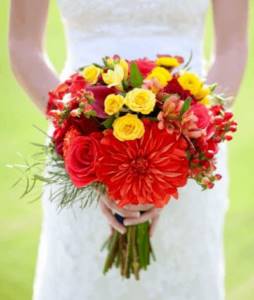
This variety allows you to create both a bright, variegated bouquet and a delicate monochromatic composition. A bride in a classic, snow-white dress will suit pale, cream flowers, a girl in a beige or golden dress - pink, yellow or lilac.
Planting chrysanthemums Bridal dress
Like any annual chrysanthemum, the Bridal Dress variety is usually grown from seeds. This can be done in two ways:
- sowing them for seedlings in early spring;
- sowing directly into open ground in May.
Procedure for planting chrysanthemums The bride's dress in each of the indicated cases has its own characteristics.
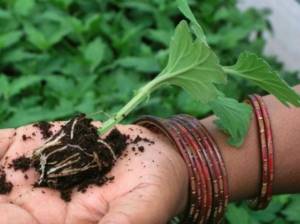
Chrysanthemums grown by seedlings bloom earlier than those sown directly in open ground
Preparing the soil and planting container
Chrysanthemum seedlings begin to be grown in March or April. At first, the seeds should be kept indoors or in a heated greenhouse.
Important! Chrysanthemum Bride's Dress, grown in seedlings, begins to bloom earlier than the one that was sown immediately in open ground.
You can buy a ready-made substrate for flowering plants. However, it is not at all difficult to prepare soil for seedlings yourself.
To do this you will need to mix in equal parts:
- land from the site;
- humus;
- peat.
It is advisable to first sift the soil mixture through a sieve - this will help make it loose. It is also necessary to disinfect the substrate by steaming it with boiling water or calcining it in the oven at a temperature of 110-130 °C.
Containers for seedlings can be individual or shared. The main requirement for them is sufficient width with a small depth. You can use wooden or plastic boxes, disposable cups, plastic cassettes, peat tablets. It is important that water does not stagnate at the roots of the seedlings, so there should be holes in the bottom of the seedling containers for drainage.
It is advisable to first disinfect the containers by treating them with a pink solution of potassium permanganate.
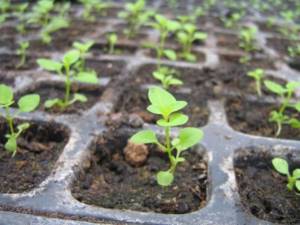
The container for growing seedlings should be wide but shallow, with holes in the bottom for drainage
Those who are going to plant Chrysanthemum Bridal Dress seeds in open ground should wait until May. However, the area for flowers must be prepared in advance, in the fall. If the soil is sandy, it should be dug to a depth of 20 cm, adding humus. Clayey, heavy soil must be supplemented with sand.
The soil reaction should be neutral or slightly acidic (pH 6.5); if this value is higher, it must be limed. It is recommended to additionally add 50 g of superphosphate and 25 g of potassium phosphate per meter of soil.
Preparation of planting material
Before planting, chrysanthemum seeds Bridal Dress require simple pre-treatment. To do this you should:
- soak them for half an hour in a weak solution of potassium permanganate or chlorhexidine;
- rinse in clean water;
- air dry.
Landing rules
If the Bridal Dress chrysanthemum is going to be grown from seedlings, then planting the seeds is done as follows:
- a layer of drainage (pieces of polystyrene foam or expanded clay) is poured onto the bottom of the prepared container;
- fill the container with soil mixture to 2/3 of the volume;
- slightly moisten the soil with a spray bottle;
- make holes or grooves 0.5-1 cm deep in it;
- sow the seeds evenly, making sure that they are not located close to each other;
- if planting is done in individual containers, 2-3 seeds are placed in each hole;
- lightly sprinkle the crops with soil;
- spray them with warm water from a spray bottle;
- cover the containers on top with transparent film or glass and put them in a warm place, providing the necessary care.
Important! If peat tablets were chosen to germinate the seeds of the chrysanthemum Bridal Dress, then they are first allowed to swell by placing them in a basin of warm water for 2-3 hours, and then used as individual containers for planting.

It is convenient to use peat tablets for sowing seeds, having previously steamed them
A couple of weeks later, after the seedlings have 2-3 true leaves, they can be picked and planted in separate flowerpots. Seedlings that are weakened or too elongated are discarded. If the Bride's Dress chrysanthemum is sprouted in peat tablets or cups, then at this stage, out of 2-3 sprouts, the strongest one is selected, and the remaining ones are carefully cut off with scissors near the ground.
Seedlings are planted in a permanent place in the flower garden in mid-May. It is best to choose a cloudy day for this. Sequencing:
- a couple of hours before transplanting, water the seedlings abundantly;
- a trench 40-45 cm deep is dug in advance in the ground, a little sand is poured onto the bottom and moistened with settled water;
- each seedling is carefully removed from the container along with an earthen lump on the roots;
- chrysanthemums are planted in a trench, leaving a distance of 30-40 cm between the bushes;
- the soil is watered and mulched (sawdust, peat).
Important! The earthen ball should be buried 1.5-2 cm into the soil, not only with the root, but also with the cotyledons. With this planting, the bush will begin to grow well and will branch abundantly.
In the case when you decide to grow the Bridal Dress chrysanthemum directly in the open ground, proceed as follows:
- 2-3 seeds are placed in prepared holes dug at a distance of 20-25 cm;
- cover them with a small layer of peat (2-3 cm);
- well watered.
To better warm the soil and preserve moisture, it is recommended to cover the holes with pieces of garden film before the first shoots appear (then it should be removed).
After the young bushes of the chrysanthemum Bridal Dress reach 5-10 cm in height, the seedlings need to be thinned out, leaving one sprout in each hole, the strongest one.
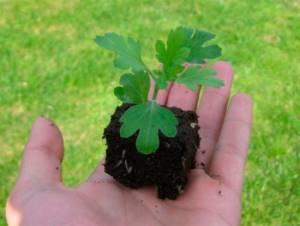
Chrysanthemum seedlings should be replanted into open ground with a clod of earth
What colors does chrysanthemum go with?
Before making a bouquet and selecting options, it is worth deciding which varieties of chrysanthemum will be used. If these are plants with small flowers, you can use them to create a simple mono-bouquet, or use them as an addition. For example, several branches can be added to a bouquet with roses or gerberas. But you shouldn’t use them in compositions with lilies of the valley or tulips; in such a combination, chrysanthemums look rude and inappropriate.
If we are talking about large and voluminous flowers, then they often act as the basis of the bouquet, and other plants only emphasize their airiness and beauty. Chrysanthemum will look good next to such neighbors as:
- eustoma;
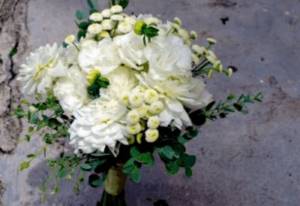
- alstroemeria;
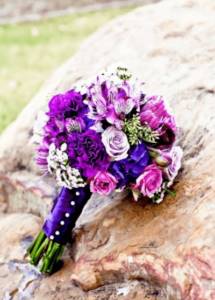
- hydrangea;
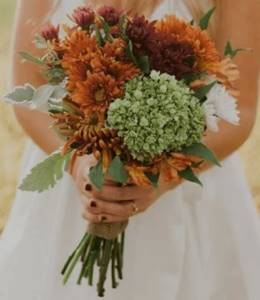
- chamomile;
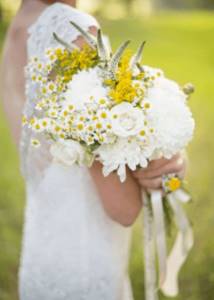
- iris.
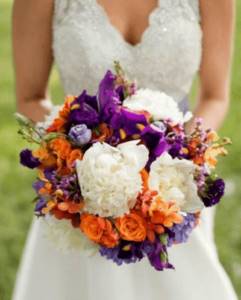
You should not combine chrysanthemums and exotic orchids or callas in one bouquet. These flowers are so different that finding the right combination is difficult even for an experienced florist. Also, you don’t need to use more than 2-3 plants in a bouquet. It is better to give the composition volume and expressiveness by choosing flowers of the same variety, but of different shapes and sizes, and also by adding decorative greenery.
Examples of wedding bouquets
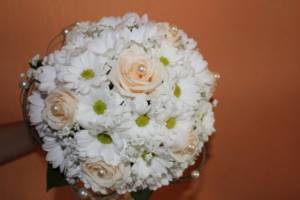
Three examples of bouquets:
- Monobouquet is the most popular option. In fact, the oriental flower is rich and symbolic, so only with its help can you say a lot. In addition, the resulting images are interesting, romantic and tender. Florists advise using an interesting color scheme. For example, combining all pastel colors or bright colors . In this case, you can get a richer wedding composition.
- Several branches of blue gerberas are ideal for a delicate sky-blue chrysanthemum. It will be possible to create, on the one hand, a gentle, and on the other, a daring and original composition.
- Bright and juicy pink roses will look perfect with single-headed snow-white chrysanthemums.
How to make a bouquet yourself
Even those who have never been involved in floral design can try their hand at making a wedding bouquet of chrysanthemums with their own hands. This flower is ideal for beginners and is a pleasure to work with. Of course, you shouldn’t take on complex, multi-tiered compositions, but it’s quite possible to make a simple round bouquet of a classic shape. For this you will need: chrysanthemums themselves (it is better to take them with a reserve), garden shears, decorative material, greenery, floral wire or ribbon. The algorithm of actions is as follows:
- All leaves are removed from the stems, yellowed and damaged petals are removed from the buds.
- The chrysanthemum with the longest and strongest stem is taken as the base, and other flowers are attached to it in a spiral. Between them you can insert sprigs of greenery or large, decorative leaves.
- When the bouquet takes the shape of a dome, the stems need to be fixed either with floral wire or special adhesive tape.
- Use sharp scissors to trim all stems at the same level.
- The base of the bouquet can be draped with fabric or wrapped in paper, mesh, or lace to hide the fixing wire or ribbon.
To decorate a wedding bouquet, you can use not only natural materials. Jewelry made from beads or rhinestones, which can be attached to flowers or stems, looks interesting and unusual. The base of the bouquet can be decorated with strings of pearls or secured with a fabric brooch. There are many options, the main thing is to use your imagination and creativity.
Chrysanthemum is a time-tested, classic option; its flowers will make the bouquet festive and solemn. This plant can decorate and complement any image, and at any wedding a composition of these delicate creatures will be appropriate. If you don't like exoticism and extravagance in wedding bouquets, chrysanthemum is the best choice.
